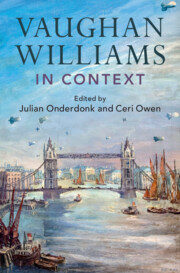Book contents
- Vaughan Williams in Context
- Composers in Context
- Vaughan Williams in Context
- Copyright page
- Dedication
- Contents
- Illustrations
- Graphs and Tables
- Musical Examples
- Notes on Contributors
- Acknowledgements
- Editorial Note
- Bibliographic Abbreviations
- Introduction
- Part I Biography, People, Places
- Part II Inspiration and Expression
- Part III Culture and Society
- Part IV Arts
- Chapter 19 Literature
- Chapter 20 Visual Art
- Chapter 21 Theatre, 1895–1914
- Chapter 22 Dance
- Chapter 23 Film
- Part V Institutions
- Part VI Reception
- Further Reading
- Index of Works
- General Index
Chapter 20 - Visual Art
from Part IV - Arts
Published online by Cambridge University Press: 28 March 2024
- Vaughan Williams in Context
- Composers in Context
- Vaughan Williams in Context
- Copyright page
- Dedication
- Contents
- Illustrations
- Graphs and Tables
- Musical Examples
- Notes on Contributors
- Acknowledgements
- Editorial Note
- Bibliographic Abbreviations
- Introduction
- Part I Biography, People, Places
- Part II Inspiration and Expression
- Part III Culture and Society
- Part IV Arts
- Chapter 19 Literature
- Chapter 20 Visual Art
- Chapter 21 Theatre, 1895–1914
- Chapter 22 Dance
- Chapter 23 Film
- Part V Institutions
- Part VI Reception
- Further Reading
- Index of Works
- General Index
Summary
This chapter argues that visual art played a generative role in the compositional processes of Vaughan Williams. His taste in painting was influenced by the art historians Bernard Berenson and Roger Fry, who lauded the formal simplicity of works by fifteenth-century Italian artists like Piero della Francesca, Fra Angelico, and Andrea Mantegna. The hymn tune ‘Mantegna’ was conceived as a ‘musical representation’ of that artist’s Agony in the Garden (c.1455–6, National Gallery, London). Reproductions of fifteenth-century paintings were displayed in the composer’s home, The White Gates, Dorking, from 1929.
English modernist painting developed rapidly after 1910. Among contemporary artists, Vaughan Williams particularly admired the work of the brothers Paul and John Nash. Their work has been described as ‘Neo-Romantic’, returning to the traditions of British landscape painting but with a modernist inflection. Vaughan Williams engaged directly with the visual legacies of the Romantic era in Job: A Masque for Dancing (1930), a musical response to William Blake’s Illustrations of the Book of Job (1826). Blake’s images were vividly translated into sets and costumes by wood engraver Gwendolen Raverat. The production represented a masterly fusion of visual and musical elements.
- Type
- Chapter
- Information
- Vaughan Williams in Context , pp. 169 - 179Publisher: Cambridge University PressPrint publication year: 2024

